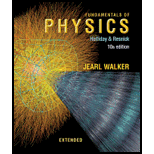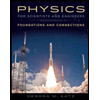
Concept explainers
SSM In a demonstration, a 1.2 kg horizontal rope is fixed in place at its two ends (x = 0 and x = 2.0 m) and made to oscillate up and down in the fundamental mode, at frequency 5.0 Hz. At t = 0, the point at x = 1.0 m has zero displacement and is moving upward in the positive direction of a y axis with a transverse velocity of 5.0 m/s. What are (a) the amplitude of the motion of that point and (b) the tension in the rope? (c) Write the standing wave equation for the fundamental mode.
Want to see the full answer?
Check out a sample textbook solution
Chapter 16 Solutions
Fundamentals of Physics Extended
Additional Science Textbook Solutions
Essential University Physics: Volume 1 (3rd Edition)
Lecture- Tutorials for Introductory Astronomy
Modern Physics
Physics: Principles with Applications
Life in the Universe (4th Edition)
Essential University Physics: Volume 2 (3rd Edition)
- As a pulse travels though a uniform medium, the speed of the pulse ____. a. decreases b. increases c. remains the samearrow_forwardTwo sinusoidal waves of the same frequency travel in the same direction along a string. If ym1 = 3.0 cm, ym2 = 4.0 cm, f1 = 0, and f2 = p/2 rad, what is the amplitude of the resultant wave?arrow_forwardA rope of homogeneous material, of length L= 20.0 m and mass M= 2.0 kg is stretched in the horizontal direction under a tension of 35.0 N. One end of the rope is oscillated transversely, with an amplitude of 0.03 cm and frequency of 15.0 oscillations per second. The initial transverse position of this end at t=0 is yi= 0.015 m, considering the y axis oriented upwards. Which function describes the transverse displacement of a point at a distance x from the oscillating end, after being hit by the wave but before the wave reaches the other end, as shown in the figure? Choose the correct alternative (option are in the image):arrow_forward
- Two identical sinusoidal waves with wavelengths of 1.5 m travel in the same direction at a speed of 20 m/s. If the two waves originate from the same starting point, but with time delay ∆t between them, and with resultant amplitude A_resultant = √3 A then ∆t will be equal to: 0.00625 sec 0.0125 sec 0.025 sec 0.01 sec 0.005 secarrow_forwardA traveling wave along the x-axis is given by the following wave functionψ(x, t) = 3.5 cos(1.5x - 8.6t + 0.46). Calculate the phase constant in radians.arrow_forwardFor a 171Hz plane traveling wave in air with a sound pressure level of 40 dB re 20 pPa, find (a)the acoustic pressure amplitude, (b) the intensity, (c)the acoustic particle speed amplitude, (d) the acoustic density amplitude, (e) the particle displacement amplitudearrow_forward
- A string with a length of 1.65 m is fixed at both ends. It is then allowed to oscillate transversely such that there are 1 nodes between the ends, with an amplitude of 16.6 cm. What is the maximum transverse displacement of the string 0.967 m from one end? Please give answer in units of cm.arrow_forwardConsider a transverse periodic (sinusoidal) wave passing through a very long string of mass density 0.250 kg/m. The wave function for this wave is found to be: y (x,t) = (0.125 m) cos [(1.10 rad/m) x - (15.0 rad/s) t] From the equation find the following quantities 1. Direction of th oscillation of the medium (i.e. which axis) 2. Direction of the motion of the wave (i.e. which axis, and ij the positive or negative direction) 3. Speed of the wave 4. Tension of the string 5. Average power P av delivered by the wavearrow_forwardA plane harmonic sound wave of amplitude 15 mPa propagates in air (ρ= 1.2 kg/m3) at 21 °C, with a frequency of 549 Hz. If the sound intensity is increased by a factor of 49, the intensity level changes by a factor ofarrow_forward
- Male Rana catesbeiana bullfrogs are known for their loud mating call.The call is emitted not by the frog’s mouth but by its eardrums, which lie on the surface of the head. And, surprisingly, the sound has nothing to do with the frog’s inflated throat. If the emitted sound has a frequency of 260 Hz and a sound level of 85 dB (near the eardrum), what is the amplitude of the eardrum’s oscillation? The air density is 1.21 kg/m3.arrow_forwardA string of mass 16.6 grams and length 0.74 meters and fixed at the ends is under tension 243 N. What is the vibrational frequency of n= 4 harmonic?arrow_forwardA certain stretched string has a fundamental frequency of 100Hz. By what factor must it’s lenght, tension, mass per until length or diameter individually be changed to raise the fundamental frequency to 200Hz?arrow_forward
 Physics for Scientists and Engineers: Foundations...PhysicsISBN:9781133939146Author:Katz, Debora M.Publisher:Cengage Learning
Physics for Scientists and Engineers: Foundations...PhysicsISBN:9781133939146Author:Katz, Debora M.Publisher:Cengage Learning
